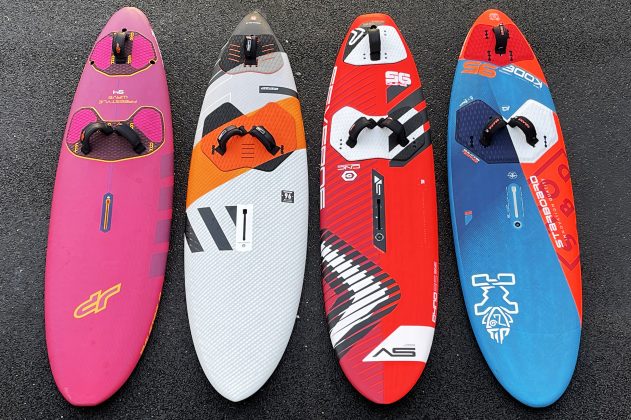2022 95 LITRE CROSSOVER BOARD TEST // ONE FOR ALL
The test team take some fresh crossover / freewave designs for a spin in the waves and flat water and let us know their thoughts! Due to COVID and delivery difficulties we have added The Quatro Power 94 Free thruster, The Goya One 3 Carbon 95 and the Fanatic Freewave TE95 which were featured in our March 2022 edition as catch up tests!
TEST EDITOR: TRIS BEST // ASSISTANT TEST EDITOR – ROB YORK
SECOND TESTERS: JOE NORTH, SCOTT STALLMAN, SAM ANSTEY, ISAAC LINES
TEST LOCATION: OVERCOMBE, KIMMERIDGE, PORTLAND HARBOUR // PHOTOS: TRIS BEST
FINDINGS
The beauty of the crossover test is even if we have changeable weather, we are given some of the most versatile boards on the market, allowing us to get out in a vast range of conditions to see what they can do. Their ability to adapt to different roles to meet the weather and conditions of the moment, provides a strong argument for a ‘one board quiver’, and we set out to see if this really was a viable option? Before we start an apology that supply lines remain disrupted due to Covid, so not all the boards we had planned to test arrived before deadline.
Out of the four-board lineup, we had two designs that were first released last year, as many brands continue the shift towards a two-year product cycle. Having tested their larger siblings in 2021, we were looking forward to getting out on these smaller 95-litre versions.
The legacy of the ‘compact’ board concept (short length, parallel rails and straighter rocker line) is certainly still evident in the crossover arena, although there have also been new development features added to the mix too, some of which are at odds with the original ‘compact’ train of thought. Narrower, more drawn-out tail outlines that encourage the rider into a more forward stance position is the standout feature seen on several boards today and is a direct conflict with the compact idea of a more rearward rider position. The advantages to each are discussed in the board’s individual writeups, but as a rough overview, the forward stance promotes more plug and play ease and balance, whereas a more rearward stance increases the sense of connection and concentrates reactivity through the back foot. As with every design process, things evolve and brands have been able to cherry-pick certain elements that work for them, whilst incorporating new ideas and concepts.
The importance of fin design and fin box placement cannot be overstated in these boards. Both have such a defining influence in the character and nature of the board’s performance. Starboard deserve credit for providing two fin setups with their Kode, but with all these boards we implore you to experiment! Swap them out for bigger fins to push their speed and bump-and-jump potential; change the central fin in the thruster setup for a softer fin to push harder through the turn … or simply shift the fins’ position forward in the box. There is so much versatility to tap into, and once you find the sweet spot, mark it lightly so that your reference point is established
SUMMARY
During the test, it became clear that whilst all these boards have immense versatility, they each also have an area in which they truly excel.
At first glance, you’d be forgiven for thinking that the Starboard Kode has the appearance of a high wind freeride board, with its low nose rocker and fuller shoulders. And, true to form, it is exceptionally gunny in nature when used for straight-line work, providing a fast, lively and engaging ride. However, down to its compact shape, two complete fin setups and extensive tuning capacity, the board’s adaptability shines through, making it one of the true all-rounders in the group. In contrast, with a strong departure from its ‘high wind freeride’ heritage, RRD’s Freestyle Wave has plenty of nose rocker, chiselled wingers and a significantly narrower tail, prompting the rider to assume a more forward stance. As with the 104 tested last year, it is undoubtedly one of the more wave-orientated boards in the crossover category, yet not detracting from the board’s deceptive turn of speed once powered. And whilst the RRD places the rider’s stance forward, the Severne Dyno does the opposite, allowing the rider to drive hard and really play their sense of connection through the back foot. There’s plenty of grip to enjoy for those willing to adapt to its rearward riding style. Lastly there’s the JP Freestyle Wave 94 – the board lineage with genuine dynasty in this category! This latest incarnation is so easy to use. Provide the power, sink into the harness and let the board do the rest. Its supplied fins do the job admirably, but to fully explore its potential, keep playing with the fin in the central box … or why not use its option to fit a foil!? The possibilities keep flourishing, year upon year.
THE LINEUP
JP AUSTRALIA FREESTYLE WAVE PRO 94
STARBOARD KODE REFLEX CARBON 95

